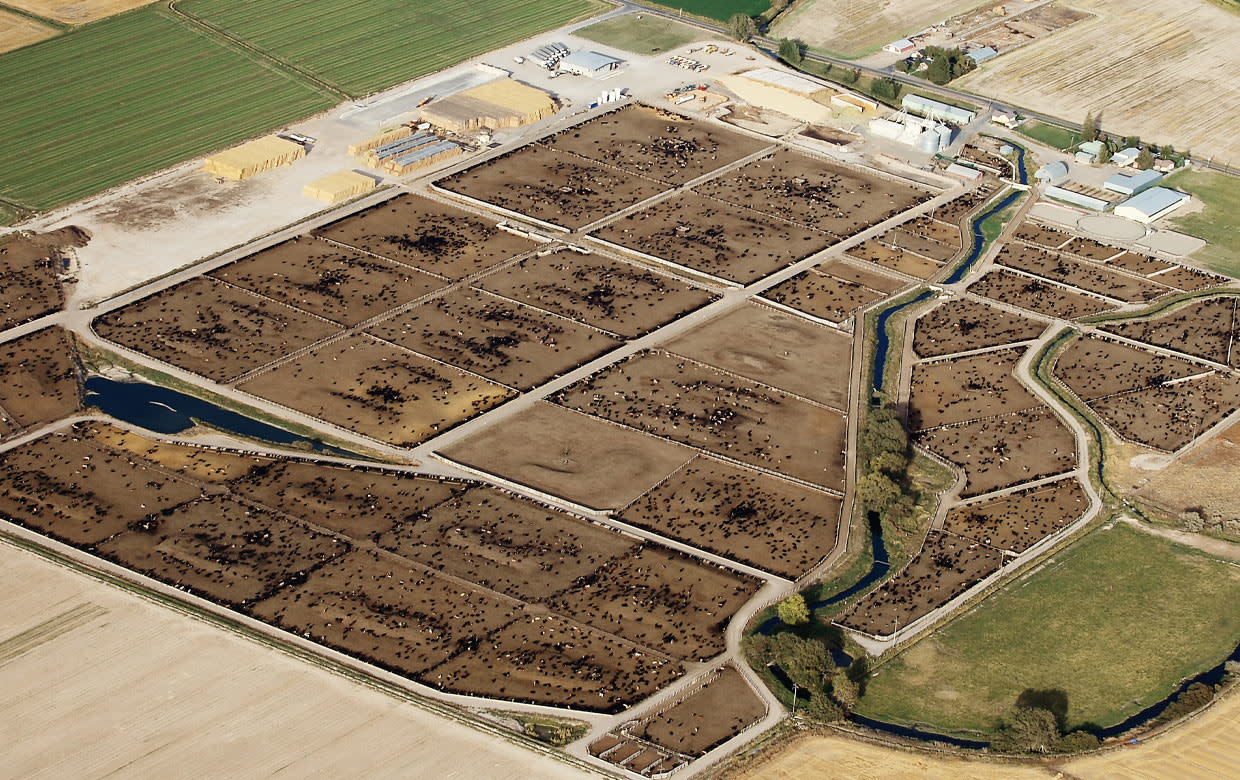




Big Ag is a powerful force in Iowa, but engaged residents are fighting back. And winning.

No state produces more meat than Iowa. Agriculture looms large in this comparatively small heartland state, which leads the country in the production of pork, poultry, eggs, and corn.
With more than 23 million hogs—according to USDA data—Iowa pigs outnumber Iowa humans by a ratio of seven to one. Chickens in the state outnumber Iowans even more dramatically, at a rate of over 16 to one.
These figures couldn't be achieved without raising animals on enormous, yet densely packed, facilities. They're known in the industry as concentrated animal feeding operations (CAFOS), but the general public might know them better as "factory farms."
Far from the idyllic setting of a small family farm—where cows are free to mosey and graze, chickens are free to forage and roam, and pigs are free to root about and play—CAFOs keep costs low by confining animals to tight spaces and bringing their food to them. Some CAFOs hold cows by the thousands, hogs by the tens of thousands, and chickens by the hundreds of thousands.
There's no shortage of concerns about the impacts these massive farms have. In the past, I've written about the ways CAFOs increase animals' risks of contracting diseases. I've talked about the inherent cruelty of gestation crates, beak-trimming, and tail docking. And I've covered just some of the ways the industry is fueling both the climate crisis and the risks of future pandemics.
This time, I wanted to focus on another aspect of industrialized agriculture: the people. Specifically, how it affects the Iowans who live near these behemoth farming operations, and what these residents are doing to protect themselves and their communities.
A community stands up to CAFOs
There are millions of confined hogs throughout southeastern Iowa. According to the USDA's 2017 Census of Agriculture, Washington County is home to more than a million farmed pigs and hogs, ranking first in the entire state for pork product sales. Most of the nearby counties are similarly inundated by industrialized hog farming. But there's one—Jefferson County—bucking the trend.
"The CAFO community has really gotten the message that people don't want these CAFOs here in Jefferson County," Diane Rosenberg told me. "People are very outspoken here. And the message has gotten across that this is not a CAFO-friendly county, and we've been able to really keep the number of CAFOs low compared to [surrounding counties]."
Rosenberg is the president and executive director of Jefferson County Farmers & Neighbors, Inc. (JFAN), a group dedicated to providing Iowans with education and resources to resist factory farm expansion. The organization works tirelessly to keep CAFOs out—in Jefferson County and beyond—monitoring for any new Big Ag developments twice a week.
In the early 2000s, shortly after starting a local newspaper in Fairfield, IA, Rosenberg became aware of the CAFO crisis facing her community. After years reporting on JFAN's efforts to halt the expansion of CAFOs, Rosenberg transitioned into activism herself. She's been with JFAN now for over a decade.
"I have this thing about fairness. I always want to do the right thing, and I want people to do the right thing. And building a CAFO in the community where it impacts neighbors, impacts water, impacts the animals; I personally feel that's not the right thing," she said. "This is an environmental justice issue... I've just seen too many people hurt by CAFOs that get built near them."
Factory farms don’t make good neighbors
There are some clear consequences to living near a CAFO. Even beyond the economic impact it has on small to mid-sized farmers, it can wreak havoc on neighbors' health.
Factory farms and their animals' waste emit a whole lot of pollutants into the air. Here's a brief list, sourced from the Environmental Integrity Project:
- Hydrogen sulfide, the source of noxious odors and the reason many households downwind from a CAFO can't even leave their windows open or let their kids play out in the yard.
- Ammonia, the cause of a range of respiratory problems both for the farm workers and farm neighbors.
- Particulate pollution, linked to asthma and heart attacks.
- Volatile organic compounds, which can cause headaches, nausea, and increased risk of cancer.
- Greenhouse gasses, the family of gasses that contribute to climate change.
For years, researchers have documented what can happen to people near CAFOs. One of the more troubling recent studies found higher rates of infant mortality in communities in close proximity to hog CAFOs.
Factory farms' sheer volume of pollution extends beyond their immediate and affects the entire globe. In 2021, a study in the Proceedings of the National Academy of Sciences identified poor air quality as "the largest environmental health risk in the United States and worldwide" and pinpointed agriculture as a leading cause. The researchers found that agricultural production in the US results in 17,900 annual air quality--related deaths, the majority of which arise from animal-based food production.
When did Iowa agriculture become so concentrated?
The agricultural landscape in Iowa was not always dominated by CAFOs. Through the middle of the twentieth century, regular families could eke out a hard-earned, but sustainable, living by running their own farm.
The shift to massive feed operations began to take form with the introduction of the soy bean, according to Chris Jones, a former researcher at University of Iowa's Hydroscience and Engineering Laboratory and author of The Swine Republic: Struggles with the Truth about Agriculture and Water Quality.
In an interview with Iowa Source, Jones says that since the 1950s, farmers began phasing out the practice of raising animals who consumed a balanced diet of alfalfa, clover, soy, and corn—crops that farmers would rotate throughout the year. Gradually, animals were moved onto crowded feedlots, while farmers focused more and more on just soy and corn. A philosophy of "all cash crop, all the time," as Jones puts it.
Through the 1970s, the federal government famously encouraged the rapid growth of midwestern farms, with Secretary of Agriculture Earl Butz exhorting the country's farmers to "get big or get out" and to plant from "fencerow to fencerow."
Farmers heeded the call and took out sizable loans to make big investments into their operations. But by the following decade, economic pressures at home and geopolitical pressures abroad led to an economic crisis that hit small and mid-sized farmers harder than anytime since the Great Depression. Some of the most impactful factors included the Federal Reserve raising its interest rates for borrowing, and President Jimmy Carter canceling contracts for the sale of 17 million metric tons of US corn, wheat, and soybeans to the Soviet Union.
Many family farms never recovered from the hit, and agriculture in Iowa hasn't looked the same ever since.
According to Food & Water Watch, the number of hog farms in Iowa dropped by 82% between 1982 and 2007. During that same time period, the average number of hogs per farm soared by a factor of 10, from just under 500 to more than 5,000.
Toledo scores a victory
Going up against an industry as large and powerful as Big Ag is a tall order, but there are plenty of inspiring success stories demonstrating the power of community action.
One such victory came last year in Toledo, IA in Tama County. Iowa Select—the states' top pork producer and the eighth largest in the US—was planning to construct a 5,000-head hog CAFO in a close proximity to the homestead of late Iowa icon Norma Lyon.
Known as "the Butter Cow Lady," Lyon found national fame for her ambitious, life-sized butter sculptures of cows and celebrities, and even a diorama of the last supper. Her family was planning on opening up a bed-and-breakfast and small museum in Lyon's honor, before finding out about Iowa Select's plans to set up shop less than a mile away.
The neighborhood rallied together in collective opposition to this CAFO. They sought help from the Socially Responsible Agriculture Project (SRAP), which works to protect "local economies from the damaging impacts of industrial livestock production," as well as the Iowa Citizens for Community Improvement (Iowa CCI), which assists communities with grassroots efforts to resist factory farming, among other social justice issues.
The final blow to the factory farm's fate came when Norma's son, Eric Lyon, placed an ad in a local newspaper on behalf of the neighborhood group. The ad read, "AMBUSHED! Size matters! These Industrial Sized Hog Units Are Not Your Average Neighborhood Pig Farm!"
Eric sent the clipping to Iowa Select and informed them that the neighborhood coalition would be holding a press conference to further spread the word. Despite having obtained a permit from the state's Department of Natural Resources, Iowa Select withdrew its application the same day it found out about the press conference.
"As soon as that ad came out, that is what turned the tide," said Rosenberg, who consulted on behalf of SRAP in this case. "Iowa Select is very sensitive about their public image."
"An educated community is an empowered community"
Iowa doesn't have strong regulations to keep the factory farm industry in check, according to Rosenberg. That's why community victories over CAFOs, like the recent one in Tama County, come when ordinary residents band together and mount "persistent" public pressure on the company proposing the farm.
"The way to really stop a CAFO—because we don't have great, strong regulations—is when the community gets very involved," Rosenberg said. "When you've got a strong community that doesn't give up, that's when you have some chance of stopping a confinement [facility]."
For years, Iowa activists have called on the state legislature to pass legislation establishing a moratorium that would halt factory farm expansion. While such legislation has been introduced multiple times, it has yet to acquire the political support needed to see the light of day. It is a testament to the power of Big Ag's lobbying influence—the moratorium efforts have been unsuccessful so far, despite the fact that 63% of Iowans would support one, according to a Johns Hopkins University survey.
Until state lawmakers catch up with their constituents and put an end to the expansion of CAFOS, citizen-led groups like JFAN, SRAP, and Iowa CCI will continue picking up the slack and building momentum for their movement, one blocked CAFO at a time.
"Going up against this industry is as big a lift as the abolitionist movement was and the suffragette movement was. It started with people speaking out, and it took a long time, but it gained support over the years," Rosenberg said. "The work that we're doing right now is the foundation, the building blocks for change that will eventually come... Am I going to see change in my lifetime? I don't know. But the industry itself is very unsustainable, and something's going to take it down, at some point."
JFAN's holds a public meeting every year, open to anyone interested in understanding the cost of factory farming. The 2023 theme was "bigger is not better," and focused on the widespread consolidation of the agricultural industry. The meeting featured speakers like Dr. Chris Jones—who was quoted in this piece—and Art Cullen, a Pulitzer Prize-winning editor of the Storm Lake Times. While each expert gave a presentation, the bulk of the meeting left time for questions and answers, during which attendees were welcomed to ask the panel of experts about factory farming and its impacts.






